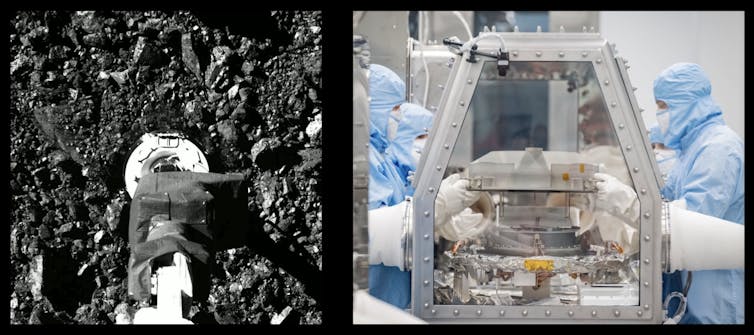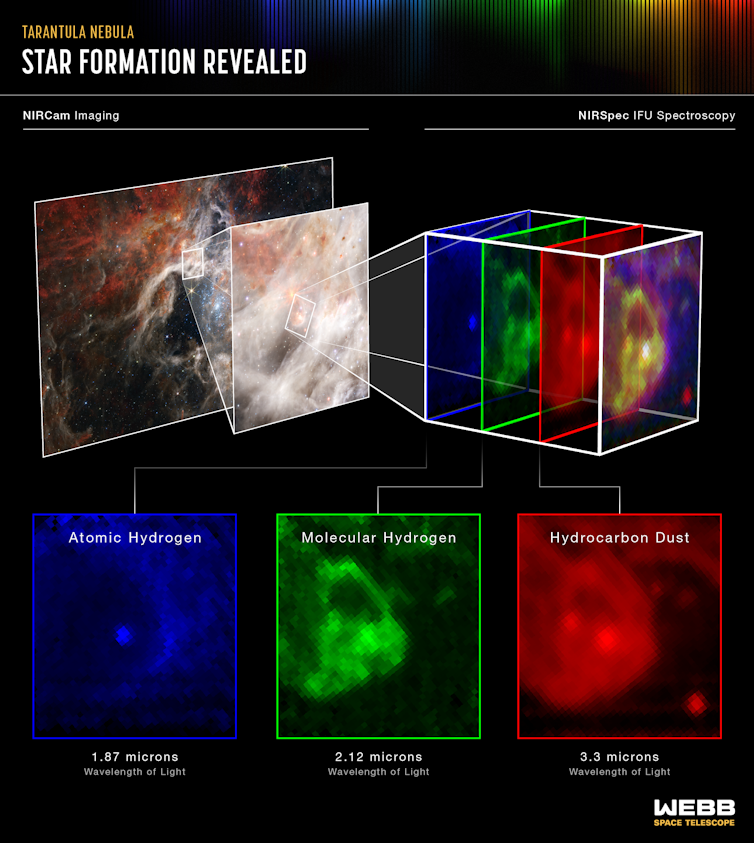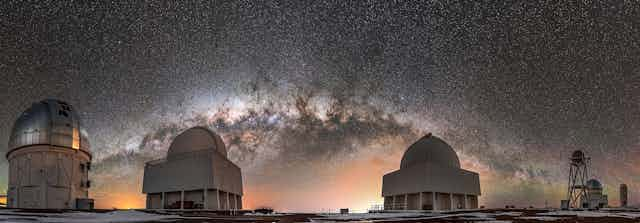NASA’s OSIRIS-REx spacecraft flew by Earth on Sept. 24, 2023, dropping off its sample of dust and pebbles gathered from the surface of near-Earth asteroid Bennu.
Analysis of this sample will help scientists understand how the solar system formed and from what sorts of materials. Scientists will begin their analysis in the same facility that analyzed rocks and dust from the Apollo lunar landings.

As an astronomer studying how planets form around distant stars, I felt excited watching the broadcast of that Bennu sample descending to the Utah desert – and a little envious. Those of us who study distant young solar systems can’t send robotic spacecraft to get a closer look at them, let alone grab a sample for laboratory analysis. Instead, we rely on remote observations.
But what astronomers can measure using telescopes is not what we really want to know – instead, we calculate the properties we’re interested in studying by observing and interpreting apparent properties from afar.
Astronomers’ tools
Asteroids are like fossils – they’re composed of rocky material from the formation and early evolution of a solar system and they are preserved nearly unchanged. That’s how the pristine Bennu samples will help astronomers learn about our solar system’s formation.
Over the past several decades, astronomers have learned that disks of gas and dust called protoplanetary disks orbit young stars. Observing these disks – located many light years outside our solar system – can help astronomers understand the early planet formation process, but they’re too distant to send a sample-return mission like OSIRIS-REx to directly measure what the dust and asteroids in these systems are made of.

All that astronomers like me can do is observe those distant regions of the universe remotely, using telescopes here on Earth or in orbit near Earth. But even with limited tools and techniques, we’ve still managed to learn quite a bit about them.
Distance and luminosity
The closest protoplanetary systems are a few hundred light years from the Sun, but we can’t directly measure distances that large. Instead, we have to determine distance indirectly using precise measurements of parallax – small changes in the apparent position of the star caused by our changing perspective as Earth orbits the Sun.
Once we know their distances from Earth, we can determine another essential physical property of protoplanetary disks: their luminosities and the luminosities of their stars.
Luminosity is an object’s power output measured in watts. The luminosity of a star like our Sun is in the hundreds of trillions of trillions of watts. Just as sunlight influences weather and the chemistry of planetary atmospheres in our solar system, the luminosity of a young star directly affects the material in its protoplanetary disk. Luminosity can alter the size and composition of dust particles that will later form asteroids and planetary cores.
But brightness does not directly indicate luminosity. The measured brightness of a star or any luminous object decreases with the square of its distance from us. We measure the apparent brightness of a star, or how bright it looks in a digital image, and then calculate its luminosity from this observed brightness and the star’s distance.
Color and temperature
Luminosity also depends on temperature – warmer objects are usually more luminous – but we can’t directly measure the temperatures of distant systems. Astronomers determine temperature using precise measurements of the apparent color of a star and of the gas and dust orbiting in its planet-forming disk.
The color images of celestial objects that you see from observatories like the Hubble or James Webb space telescopes are composites of multiple images taken through a series of colored filters.

For astronomers, colors are numbers describing the brightness of an object at a particular wavelength compared with its brightness at another wavelength. Warmer objects emit more blue light relative to red light, so their color looks more blue and the corresponding number is smaller. Astronomers measure color in even more detail by passing starlight through a small prism installed in the telescope’s camera. This prism disperses the light into a spectrum.
The spectrum of light from a star and its surrounding material isn’t a smooth rainbow of color. Sharp bright and dark features in the spectra indicate the presence and relative abundances of atoms, molecules and even minerals. These chemical elements emit or absorb light in unique and recognizable combinations of colors.
Measurement and interpretation
Can you see a theme emerging? Astronomers can measure only a handful of apparent properties: brightness, color, position in the sky, shape, angular size and how each of these changes with time. These are the same properties each of us measures with our senses to navigate our surroundings in everyday life. They’re nothing exotic or special.
And yet everything astronomers know about distant solar systems and their formation we have derived from measurements of these familiar and unremarkable apparent properties. The rich and detailed descriptions that we’ve come to expect in astronomy and astrophysics come from applying our understanding of chemistry and physics to these measurements.
The arrival of the Bennu sample is exciting because it is “real.” In the coming months and years, scientists will examine this dust to inform our studies not only of asteroids and interplanetary dust, but also of interstellar dust in solar systems farther afield. I am eager to see what these new details will teach us about cosmic dust, some of the primary building blocks of planets everywhere.

